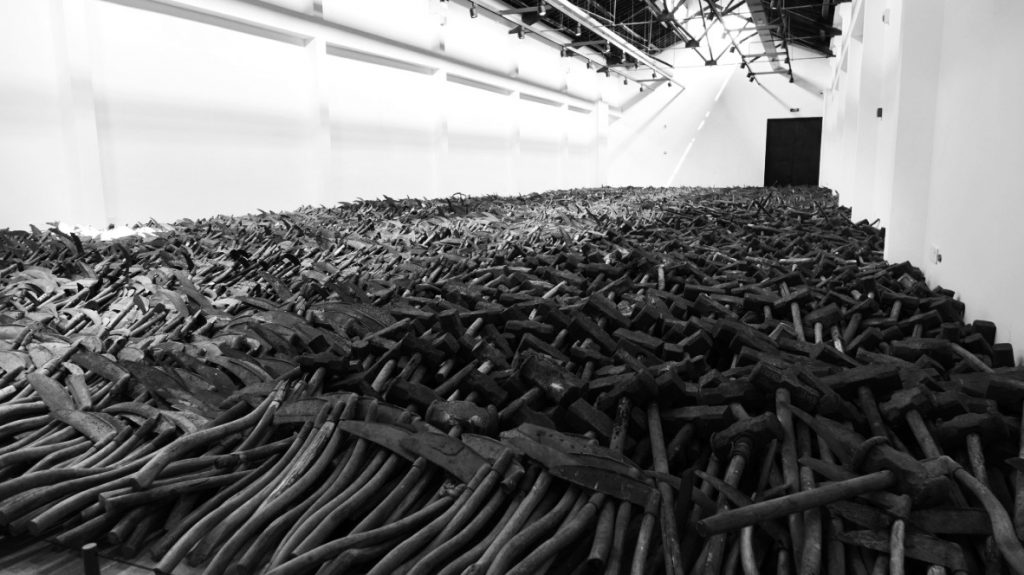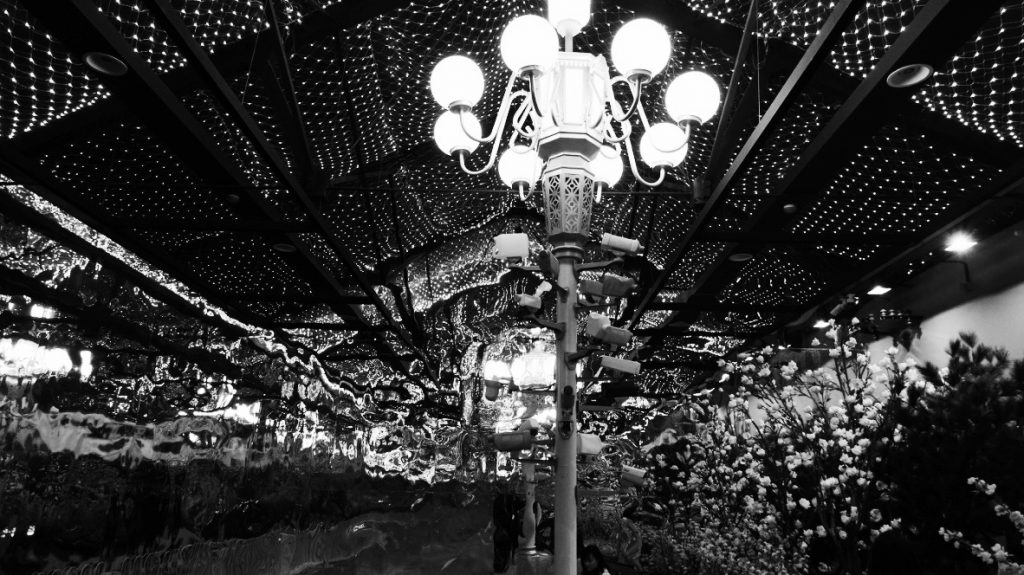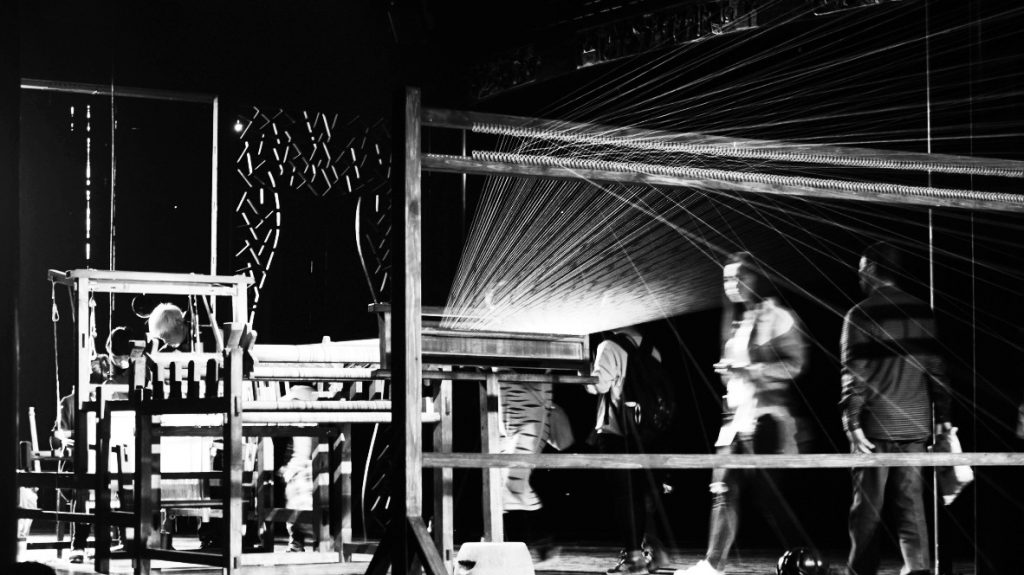The Art of Quiet Speaking
Utopias/Heterotopias: Wuzhen International Contemporary Art Exhibition
North Silk Factory and West Scenic Zone, Wuzhen
28.03.16 – 26.06.16
Wuzhen, otherwise known as the Venice of the East, is a picturesque water town two hours away from of Shanghai, in the northern Zhejiang Province. It’s a place that feels beautifully tragic, as if one is finding something just as it ends. Chen Xianghong, CEO of Wuzhen Tourism, has plans to make sure that end doesn’t come. Having spent his childhood here, he has been slowly overseeing the revitalisation of his hometown.
Wuzhen is a town of two parts: the modern town, which is where the old Silk Factory resides, and the historic water town ( the West Scenic Zone ), a restored Ming and Qing Dynasty village of cobbled streets, canals, bridges and traditional houses. The Zone is the picturesque, Venice-like part. After paying to enter, one witnesses a vast organisation of about a hundred families, dressed in distinctive blue tunics, living and working here, running the hotels and restaurants, and ferrying tourists in the ubiquitous electric trams.
Under Chen’s guidance, Wuzhen has become a popular tourist attraction, playing host to the Wuzhen Theatre Festival, the Mu Xin Art Museum, the World Internet Conference and, now, Utopias/Heterotopias, a contemporary art exhibition that trails through the West Scenic Zone and the renovated North Silk Factory. Organised by Chief Curator Feng Boyi, with a curatorial committee that includes Hou Hanru and Uli Sigg, Boyi has assembled some forty artists from around the globe, including Xu Bing, Olafur Eliasson, Bill Viola and Ai Weiwei.
The work Coloured House, by artist Ai Weiwei, is a structure made from parts of abandoned trational homes from southern China, painted in modern household paint. It’s also emblematic of the exhibition’s practice of the art of quiet speaking.
In the exhibition’s introduction we are reminded that utopia is an illusory state, an ideal society that embodies human aspiration, whereas heterotopia is ‘a place of transcendence and a place of reality’. A heterotopia, according to Foucault, is a representation of, or an approximation to, a utopia. He likened it to a mirror, which we in the real world look through to the utopia of the reflection, which does not exist. The heterotopia, then, is the action at the mirror’s surface, the friction between the real and the reflection – in other words, the place by which utopias can be approximated in a real space. It can also be a site of contestation, where several spaces operate in the same place – as with Wuzhen, where a ‘real’, historic, tourist attraction exists within a modern town, an imaginary idyll within an ordinary locus.
A third state, one likely to be more familiar to contemporary audiences, is dystopia, which could conceivably be described as the mental state created unintentionally by heterotopias when they pursue utopian visions. Dystopic states, despite their enormous influence on popular culture – think The Matrix, The Hunger Games or The Island – do not feature in contemporary art practice ( within this exhibition the word appears only once in the exhibition catalogue ), which may seem anomalous in the context; however, as with Weiwei’s Coloured House, what is not said, speaks clearly.
Take, for example, Mao Tongqiang’s Tools, which consists of 30,000 hammers and sickles, laid in rows. ‘The metaphor here is self-explanatory’ reads the exhibition essay, but it is also explicitly one about the past. However, one cannot look at the field of tools and not think about the workers who used them, and of the millions of workers who still work in perilous conditions. While the artwork deals explicitly with history, it resonates with today’s dystopic conditions.
Then there is Song Dong’s Avenue Square, an enclosed space, the walls and ceiling of which are lined with a mirrored surface, while the length is dressed to resemble a familiar Beijing street. Song invites the viewer to stop and use the space, ‘gather, eat with friends, pass the time, or entertain yourself on this street’, a seemingly benign invitation to an unremarkable interaction, made complicated by the red-painted rear wall reminiscent of the buildings surrounding Tiananmen, and the antique lamppost, like those on Chang’an Avenue, which leads to the Square. References to Tiananmen are only ever spoken quietly, and so it is quite understandable that the exhibition posits the work as being a sort of ‘every street’ .
What brings this quiet historic reference chillingly forward, from heterotopic past to dystopic present, is when the viewer realises that the fake surveillance cameras, made of detergent bottles, contain real cameras, the footage playing in an adjoining room. Further, the combination of the cameras and the mirrors recalls Jeremy Bentham’s concept of a panopticon, the model prison the design of which allowed for the prisoners to be observed by a single guard. While it isn’t possible for the guard to watch all of the prisoners at once, the inmates can never know whether they are under surveillance, and thus effectively guard themselves. The work is a stark reminder that every action one undertakes – in the age of WeChat and other social media applications – is monitored, archived, and exists as part of the evidence chain.
Eliciting similar concerns is the Dragonfly Eyes trailer by Xu Bing, for a film made entirely from footage assembled from the millions of surveillance cameras around China. The trailer takes footage from convenience stores, roadside incidents and even people’s homes, for what will eventually become a narrative-form feature film. As with Avenue Square, Xu Bing’s work has a cascade effect on the viewer: first, one views with the same voyeuristic fascination as when watching reality TV; then comes a dawning realisation – how many cameras does one pass each day? The thought that there is very little of our lives that isn’t viewable is overwhelming. As with Bentham’s panopticon, we have created a society in which we can never know whether we are being observed.
Among the work of the international artists, there are a few crowd-pleasers – Florentijn Hofman’s Floating Fish, for example, is sure to gather crowds of selfie-takers – but many of them seem to connect obliquely with the curatorial theme. An unquestionable standout is Ann Hamilton’s Again, Still, Yet, which turns a traditional Chinese theatre into a silk loom by connecting the seats with the stage via silk threads. One of the townswomen works each day to weave a 20-metre tapestry, and the inclusion of work songs and bells, and the light filtering through the window behind the stage, transform the space into something that straddles the strata of time. The effect is bewitching – until the weaver stops and laughingly complains of being tired from the effort required, reminding us that utopias also require a workforce.
Another is John Körmeling’s ANYWAY, a deceptively simple piece located at one of the gates leading into the Zone. It consists of a revolving circle, matching the surrounding paving, so that when one stands on it one is both entering and exiting at the same time. Thus, one can look from the utopia inside to the dystopia outside, although with the many workers scurrying after the tourists, playing Morlock to our Eloi, one wonders in which direction dystopia lies.
Other artists, such as Oliver Herring and Jaffa Lam, seem intent on working towards sustainable heterotopias in their practice, seeking to ameliorate the more undesirable effects of chasing utopia. Herring’s Areas for Action collaborates with members of the local community to engage with, and document, the renovation of the Silk Factory in a way not wholly performative, nor object based. By working with locals from the town, Herring invites an element of risk and uncertainty, relinquishing the usual role of artist progenitor for one of social experimenter – a role which seeks to elicit positive change in the volunteering participants while leaving little behind but documentary evidence.
For the work Bleaching, Jaffa Lam worked with members of the Hong Kong Women Workers’ Association ( HKWWA ) to unthread, bleach and recombine fabric elements ( from fabric shops closed due to gentrification ) to create new forms which are then suspended as projection surfaces, like small floating worlds. Lam’s practice incorporates elements of education, social justice and community-based collaborative actions. With this, and previous works, she is engaging in a dialogue about what a sustainable artistic and heterotopic practice means in an urban, neoliberal, environment, which more than ever leans towards the dystopic.
As one crosses the threshold when leaving the West Scenic Zone, there is a sense of being expelled from utopian space – albeit one resembling Fantasy Island – much like Adam and Eve after the Fall. That such an ambitious exhibition could have been staged in such a place, successfully, is perhaps surprising enough; yet more surprising is that with the art of quiet speaking it has been allowed to say so much. With the promise of the project having future iterations, one can only hope that it continues to explore utopia, heterotopia and perhaps even dystopia, in order that it might speak a little louder.
轻声交谈的艺术
《乌托邦异托邦金乌镇国际当代艺术邀请展》
北栅丝厂和西栅景区,乌镇
2016年3月28日 – 2016年6月26日
乌镇,也被称作东方威尼斯,位于浙江省的北部,是一个距离上海以东两小时车程的风景如画的水乡小镇。这是一个能让人感受到优美悲剧的地方,就好像是要寻找什么会终结的事物。陈向宏,乌镇旅游股份有限公司的总裁,则有着完备的计划以确保这样的终结并不会到来。他在乌镇度过自己的童年,一直缓缓地观望着自己故乡的振兴。
乌镇有两部分:旧丝厂所在的现代城镇;西栅景区所在的历史悠久的水乡是一个翻新了的有着鹅卵石街道、运河、小桥以及传统古屋的明清小镇。后者风景如画,可以媲美威尼斯。付费进入之后,人们可以看到一片经过组织的景观,那里有大约百余户家庭,大家穿着特别的蓝布长衫,居住并工作于此,经营旅店、餐厅,还有无处不在的载客电车。

Mao Tongqiang, Tools, Objects, Readymades, 2008. Dimensions variable. 毛同强 《工具》,2008,各种尺寸.

Song Dong, Avenue Square, 2015-16, plastic mirrors, plastic bottles, imitation trees and flowers, benches, crystals, coloured lights, speakers, camera equipment, guard rails, LED lights, steel, site-specific dimensions. 宋冬 《街广场》( 2015 – 2016 ),玻璃镜、塑料瓶、假树、 假花、长椅、水晶、彩色灯光、演讲者、摄影设备、防护轨、LED灯、钢,特定尺寸.
在陈向宏的指导之下,乌镇成为一个颇受欢迎的旅游景点,它是乌镇戏剧节、木心美术馆、世界互联网大会,还有现在这个“乌托邦异托邦”展览的主办地,这一当代艺术展览贯穿了西栅景区以及修复后的北栅丝厂。展览由主策展人冯博一组织,策展委员会包括了侯瀚如和乌里希克等人,聚集了来自全球的大约40位艺术家,比如徐冰、奥拉维尔埃利亚松( Olafur Eliasson )、比尔维奥拉( Bill Viola )和艾未未。
参展艺术家艾未未的作品《色房》,一个由中国南部被废弃的传统老屋的部件组成而来的结构体,经由现代建筑油漆的绘制,同时也象征着展览“轻声说话”的艺术实践。
在展览介绍中,我们被提醒注意乌托邦是一种幻象,一个体现着人类愿望的理想社会,而异托邦则是“一个超越之地,又是一个真实之场”。按照福柯的观点来看,异托邦是一种乌托邦的表征,或其近似物。他将其比作一面镜子,我们在真实世界中透过它看到了乌托邦的反射,而它又并不存在。因而,异托邦是发生在镜像表面的行动,是介于真实和反射之间的摩擦力金换言之,它是一处乌托邦可以在真实空间中得到近似物的所在。它还可以是一处若干空间集中于同一地点而产生论争的地方,就像是乌镇,这个现代小镇集中了“真实的”、历史性的、旅游景区式的各种存在,它是身处于平凡之所的一首虚构的田园诗。
第三种状态,或许更为当代受众所熟知,是反乌托邦( dystopia ),它可以被描述为是异托邦在追求乌托邦愿景时的一种无意识的精神状态。反乌托邦的状态,尽管对流行文化有着巨大的影响力金比方说《黑客帝国》、《饥饿游戏》或是《逃出克隆岛》,但是并没有被突出呈现在这个展览的当代艺术实践中( 事实上,这个词只在展览画册中出现过一次 )。而这一点在这个语境当中似乎显得异常,就像艾未未的《色房》一样,那些没有说出的话语却不言自明。
以毛同强的《工具》为例,作品由三万个排布在一起的锤子和镰刀组成。“这里的隐喻是不言而喻的”,展览文章如此写道,但它同时也是一件有关过往的作品。然而,人们不能只是看着布满工具的场地而不去思考那些使用工具的工人们,尤其是那些仍然在危险条件下工作的数以百万计的工人。虽然作品陈述的是历史,它还是与今天的错位情境产生着共鸣。
然后,还有宋冬的《街广场》,一个墙与天花板都安装着镜子的封闭空间,其长度则让人想到为人熟悉的北京街道。宋冬邀请观众驻足并使用这一空间,“在这条街上聚会、和朋友吃饭、消磨时光、或是自娱自乐”,像是对一次不起眼的互动发出的友善邀请,不过这个空间的背景实则有着复杂的注解,远处的墙被粉刷成红色,会让人联想到那些天安门附近的建筑,而复古的路灯则好像来自通往天安门广场的长安街。这些对天安门的指涉仅仅以非常安静的方式被言说着,因而也不难理解为何展览要将这件作品假定为是在指涉“每一条街道”。
将这种安静的历史指涉冷静地从异托邦的过去向着错位的现在推进的,是当观看者意识到那些假的监控摄像头之时。它们用清洁剂的瓶子做成,里面包含着真的照相机,但播放的素材则来自一个相邻的房间。此外,相机和镜子的组合叫人想起杰里米边沁( Jeremy Bentham )的全景监狱概念,其设计可以使得一位看守全面地观察犯人。尽管看守并不能同时观测到所有的服刑犯,但犯人却永远无法知道自己是否正在受到监视,因此就能有效地达成自我防范。这件作品犀利地指出了,在微信和其他社交媒体盛行的年代,人们的一举一动其实都监督和存储,并作为证据链的一部分而存在。
提醒人们关注同样话题的还有徐冰的《蜻蜓之眼》,这部电影完全由遍布中国各处的数百万个监控摄像头所拍摄到的素材组成。这些素材片段来自于便利店、街边甚至是人们的家里,并且最终串联成一个有叙事形式的长片。与《街广场》一样,徐冰的作品对观众产生着瀑布般倾泻而下的串联效应:首先,人们怀揣着像是在看真人秀电视节目那样的窥私癖幻想;其次则会逐渐意识到我们每天究竟路过了多少个摄像头?但凡想到我们的日常生活中只有极少的部分是不可见的,就有些透不过气来。像边沁的全景监狱一样,我们创造了一个我们永远不知道自己是否正在被人观看的社会。
在国际艺术家当中,有一些人的创作是极受欢迎的。比方说,弗洛伦泰因霍夫曼( Florentijn Hofman )的《浮鱼》一定会吸引大量自拍的人;但是更多的作品则似乎倾向于和策展的主题产生关联。安汉密尔顿( Ann Hamilton )的《唧唧复唧唧》毋庸置疑是尤为突出的,作品用丝线将舞台及底下的座椅相连,从而把一个传统的中国剧场转变成了一台丝织机。每天会有一位本地的妇女在那里工作,织出长达20米的挂毯;劳动号子的乐声和钟声,还有舞台背后窗户里滤进来的光线,都被包括在作品之中,从而将这一空间转化成了可以跨越时间断层的事物。作品产生的效果非常迷人,直到织布者停下来,笑着抱怨工作的辛劳金这提醒着我们乌托邦也同样要求劳力生产。
另一件作品是约翰考美林( John Körmeling )的《任何方向》,这件看起来简单的作品坐落在进入乌镇景区的大门之一。作品由一个旋转的圆所构成,与周边的铺石路面相匹配,当观众站在作品面前时,他同时处于进入和离开的状态。因此,人们就能够从乌托邦的内里看向反乌托邦的外部。尽管不少工人在游客身后疾走,就好像在扮演“时间机器”中生活在地下的莫洛克人,而我们是生活在地面的艾洛伊人,不过人们总是会想要知道反乌托邦究竟在哪个方向。
其他人的作品,比如奥利佛赫尔宁( Oliver Herring )和林岚( Jaffa Lam ),似乎打算将他们的实践努力地朝向持续的异位错乱( heterotopy ),寻求对于在追逐乌托邦的过程中带来的不良效应所进行的改良。赫尔宁的《行动区域》与当地人( members of the local community )合作,纪录了旧丝厂的改造,其互动参与和纪实的方式既非全然的表演性,也并不以物件/对象为基础。通过与乌镇当地人的协同工作,赫尔宁将冒险与不确定性的元素纳入作品之中,并且弃置了那种通常作为社会实验者兼先驱的艺术家的角色金他的角色旨在引领出志愿参与者的积极变化,并且除了文档纪实证据之外几乎没再留下什么。

Ann Hamilton, Again, Still, Yet, 2016, mixed media, dimensions variable. 安·汉密尔顿 《唧唧复唧唧》( 2016 ),多媒介,各种尺寸.
而林岚的作品《漂白》,则是她与香港女工会( HKWWA )成员的合作,她们将受到乡绅化进程影响而濒临倒闭的布料店中的织物进行拆解、漂白和重组,以创造出新形式,之后将它们悬挂起来作为投影布面,像是一个个小小的悬浮世界。林岚的实践包含着教育、社会公正以及基于社区的合作行动等元素。她通过这件作品和此前的创作,就可持续发展的艺术以及异位实践在一个城市化的、新自由主义的环境中意味着什么,提出了自己的观点,而这当然仍然指向着错位的现实。
当穿过门槛离开西栅景区时,好像有一种被乌托邦的空间驱逐了的感觉金虽然就和梦幻岛一样金有点像是堕落后的亚当与夏娃。这样一个野心勃勃的展览能够成功地被置于这样一个地方,或许挺令人惊奇的,而更为惊奇的是通过轻声交谈的艺术,它竟然已经被允许进行了如此多的诉说。此外,这个项目还将有未来迭代的承诺,让人们期待它会持续地顺次探索乌托邦、异托邦,甚至是反乌托邦,并且希望它在未来可以谈论得更响亮一些。